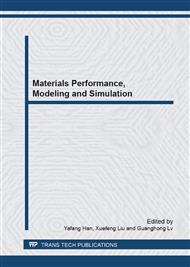p.294
p.299
p.303
p.308
p.316
p.322
p.328
p.337
p.343
W-Ti Alloy Prepared by Hydrogen Reduction of Nanometer WO3-TiH2 Powders
Abstract:
In this study, TiH2 and WO3 powders were co-milled together, then the ultrafine powders were reduced at H2 atmosphere, and W-Ti alloys were prepared by the solid phase sintering. The main purpose of WO3 powder instead of the W powder was to use the transition of the lattice type of WO3, and the lattice distortion and defects in the lattice of W would promote Ti atom diffusing into W. It was easy to form a W-rich solid solution and reduce the effect of Ti-rich phase. The results showed that when the milling time of WO3-TiH2 was 24h, the particle size of mixed powder reached nanoscale, and WO3 particles were coated on the surface of TiH2 particles. The particle size changed unobviously with the increase of the milling time. The XRD analysis showed that the milled WO3 and TiH2 were not decomposed in the milling process. When WO3-TiH2 milled powders were decomposed in the H2 atmosphere at 800, WO3 reduction was not sufficient, and the middle phase of WO2 was existed. When the reduction temperature was 850 for 2h, WO3 was reduced to W, and the phase of WO2 was disappeared. A small amount of TiO2 was formed by the decomposed Ti and decomposed O from WO3. W-10Ti alloys were prepared by the solid-phase sintering with the reduced powders at 850. It was found that the amount of W-rich solid solution in W-10Ti alloy was decreased, because the diffusion of Ti to W was inhibited by a small amount of TiO2 in grain boundaries during the sintering process.
Info:
Periodical:
Pages:
316-321
Citation:
Online since:
March 2013
Authors:
Keywords:
Price:
Сopyright:
© 2013 Trans Tech Publications Ltd. All Rights Reserved
Share:
Citation:


